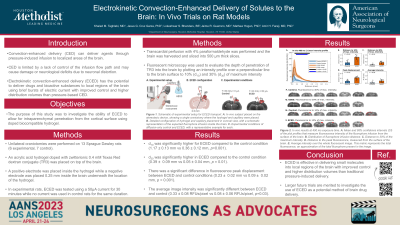Electrokinetic Convection-Enhanced Delivery of Solutes to the Brain: In Vivo Trials on Rat Models
Electrokinetic Convection-enhanced Delivery of Solutes to the Brain: In Vivo Trials on Rat Models
Friday, April 21, 2023


Khaled M. Taghlabi, MD
Postdoctoral Research Fellow
Houston Methodist Hospital
Houston, Texas, United States
ePoster Presenter(s)
Introduction: Convection-enhanced delivery (CED) can deliver agents through pressure-induced infusion to localized areas of the brain. However, CED is limited by a lack of control of the infusion flow path and may cause damage or neurological deficits due to neuronal distortion. Electrokinetic convection-enhanced delivery (ECED) has the potential to deliver drugs and bioactive substances to local regions of the brain using brief bursts of electric current with improved control and higher distribution volumes than pressure-based CED. We studied the ability of ECED to allow for intraparenchymal penetration from the cortical surface using doped biocompatible hydrogel.
Methods: Unilateral craniotomies were performed on six Sprague Dawley rats (3 experimental, 3 control). An acrylic acid hydrogel doped with zwitterionic 0.4 mM Texas Red dextran conjugate was placed on top of the brain. A positive electrode was placed inside the hydrogel while a negative electrode was placed 0.25 mm inside the brain underneath the location of the hydrogel. In experimental rats, we tested ECED using a 50µA current for 30 minutes while no current was used in control rats for the same duration. Transcardial perfusion with 4% paraformaldehyde was performed. The brain was harvested and sliced into 500 μm thick slices. Fluorescent microscopy was used to evaluate the depth of penetration by plotting an intensity profile over a perpendicular line to the brain surface to 15% of maximum intensity.
Results: The depth of penetration was 708.21 ± 484.54 µm with control and 1864.85 ± 328.81µm with ECED (p=0.03). There is a statistically significant difference in depth of penetration between control and ECED trials.
Conclusion : ECED is effective in delivering small molecules into local regions of the brain with improved control and higher distribution volumes than traditional pressure-induced delivery. Larger future trials are merited to investigate the use of ECED as a potential method of brain drug delivery.
Methods: Unilateral craniotomies were performed on six Sprague Dawley rats (3 experimental, 3 control). An acrylic acid hydrogel doped with zwitterionic 0.4 mM Texas Red dextran conjugate was placed on top of the brain. A positive electrode was placed inside the hydrogel while a negative electrode was placed 0.25 mm inside the brain underneath the location of the hydrogel. In experimental rats, we tested ECED using a 50µA current for 30 minutes while no current was used in control rats for the same duration. Transcardial perfusion with 4% paraformaldehyde was performed. The brain was harvested and sliced into 500 μm thick slices. Fluorescent microscopy was used to evaluate the depth of penetration by plotting an intensity profile over a perpendicular line to the brain surface to 15% of maximum intensity.
Results: The depth of penetration was 708.21 ± 484.54 µm with control and 1864.85 ± 328.81µm with ECED (p=0.03). There is a statistically significant difference in depth of penetration between control and ECED trials.
Conclusion : ECED is effective in delivering small molecules into local regions of the brain with improved control and higher distribution volumes than traditional pressure-induced delivery. Larger future trials are merited to investigate the use of ECED as a potential method of brain drug delivery.
